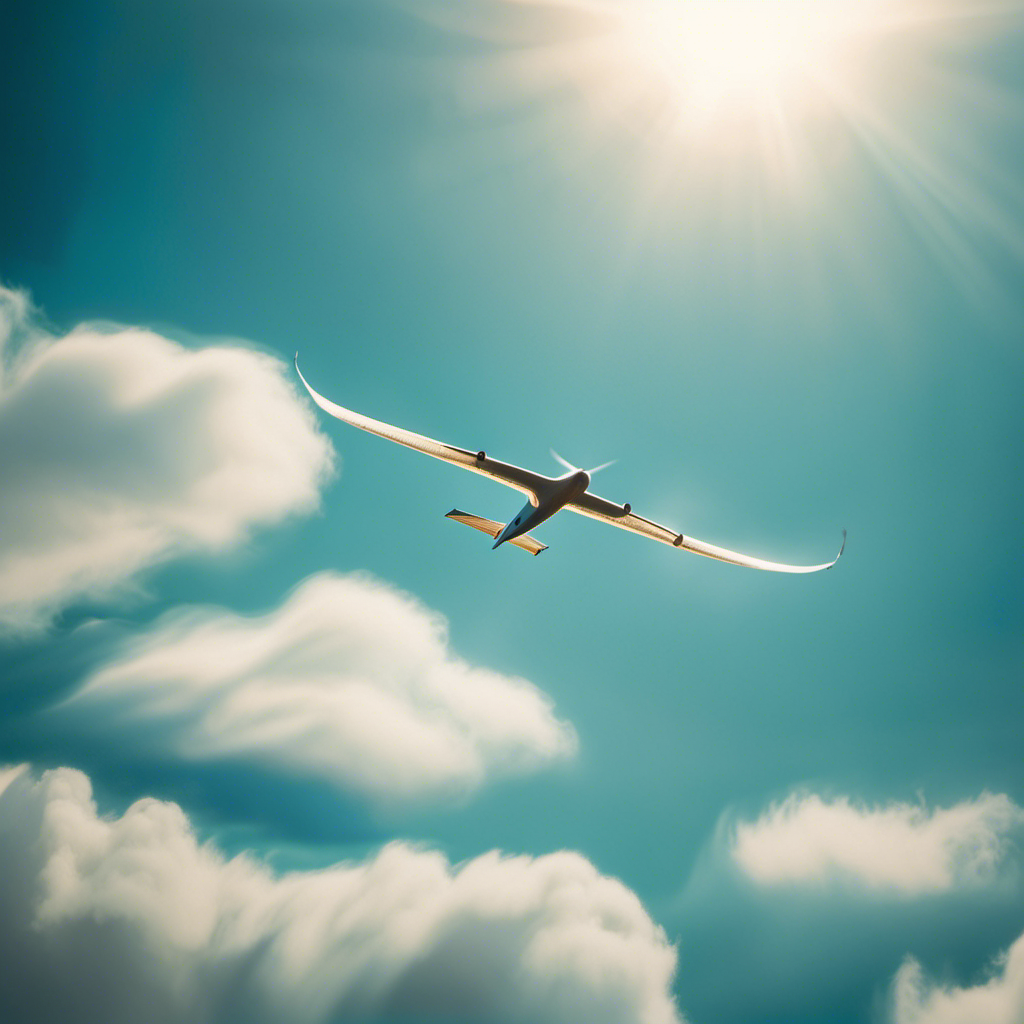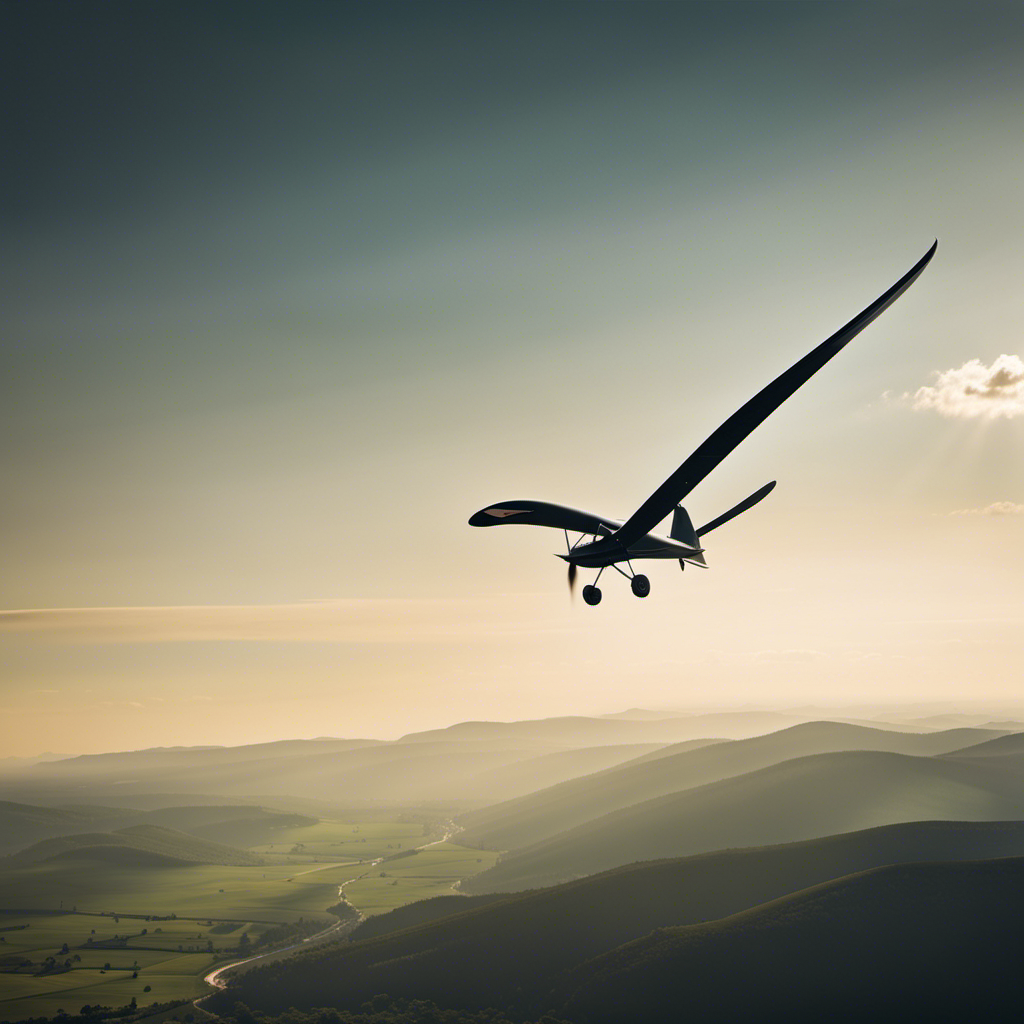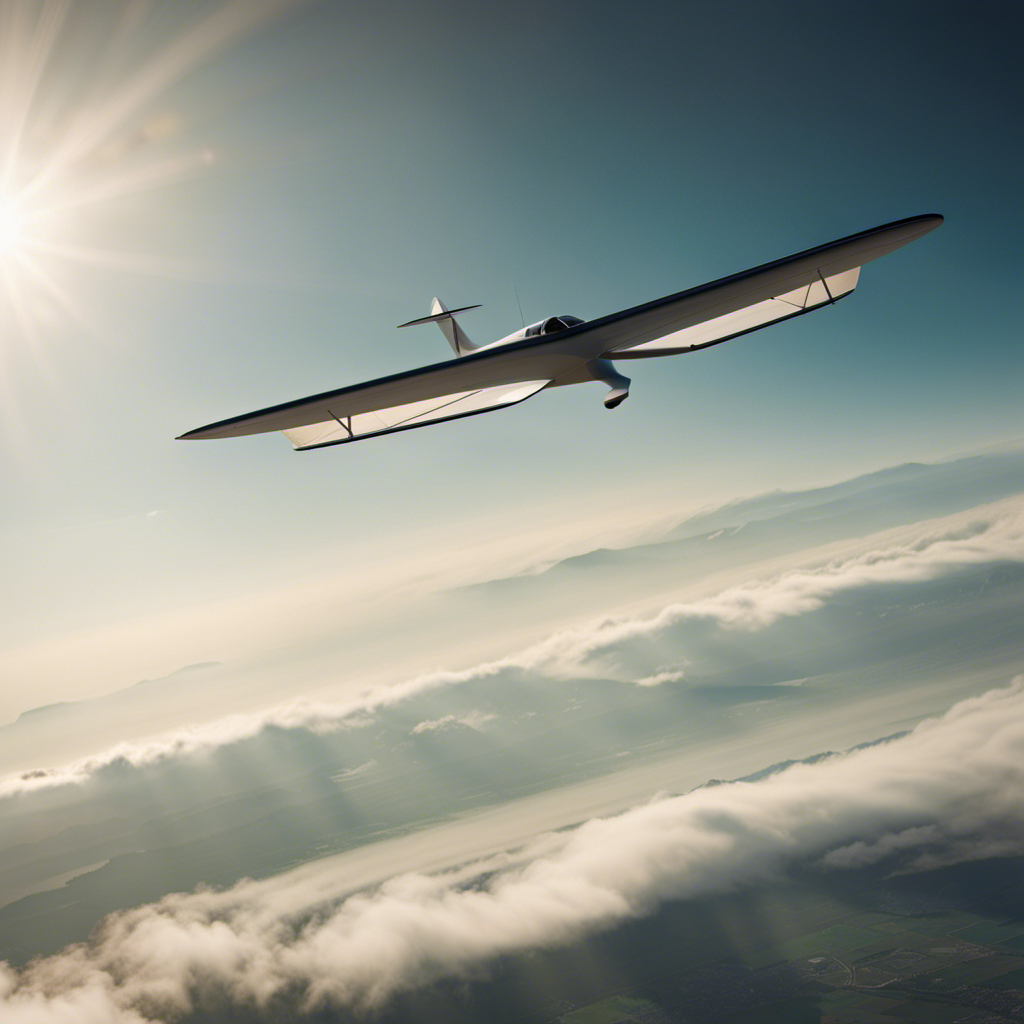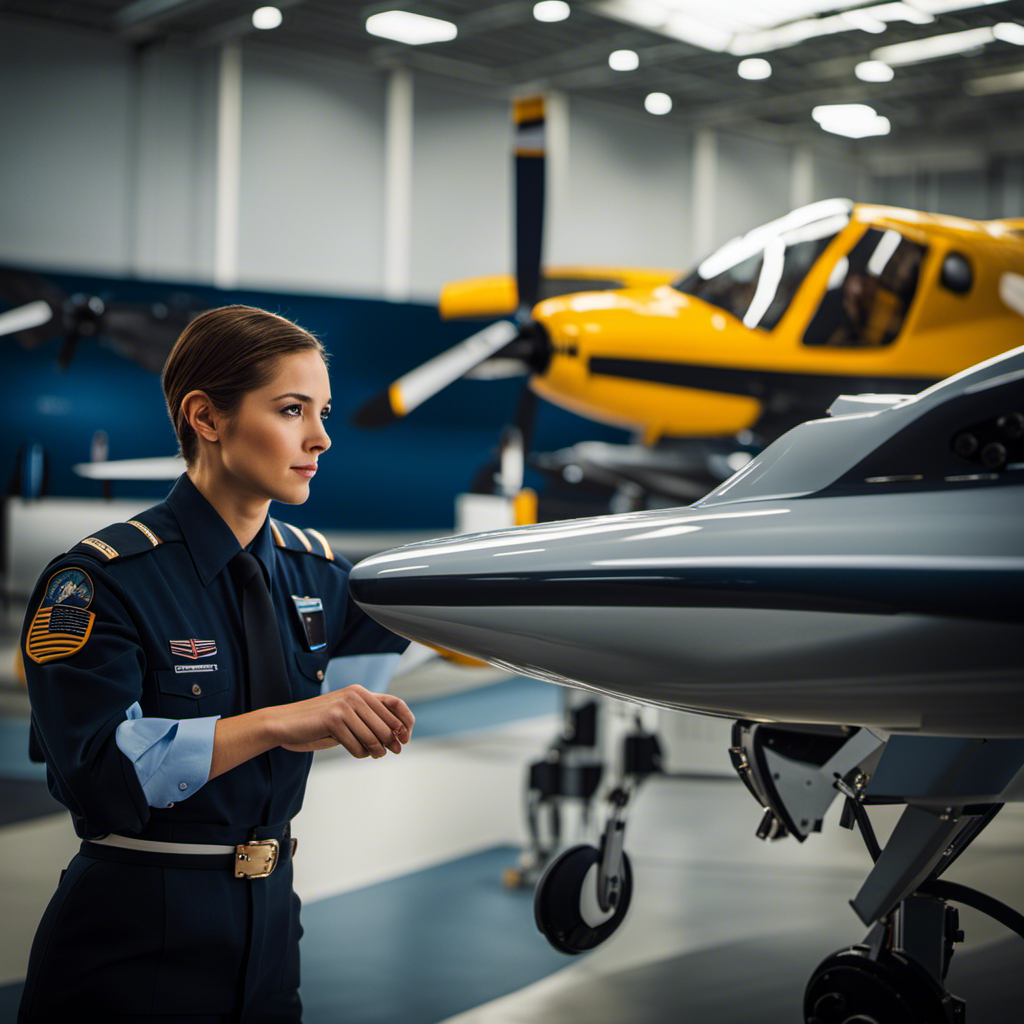Flying in a glider is reminiscent of gliding through the skies on the wings of a bird. It is the most serene way of flying, allowing me to feel the breeze on my face and revel in the freedom of the vast open sky.
In this article, I will delve into the history of glider air, how it works, the different types of gliders, and the training and certification required to become a glider pilot.
Join me as we explore the exhilarating world of glider air and discover the challenges and skills needed to master this extraordinary form of aviation.
Key Takeaways
- Glider air competitions and events showcase pilot abilities and test their expertise in various challenges and maneuvers.
- Glider air destinations such as the Alps, the Great Basin, and New Zealand offer picturesque landscapes and thermals that attract glider pilots.
- Beginners should focus on maintaining steady speed and altitude, practicing takeoffs and landings, paying attention to instruments, and making gentle control adjustments.
- Glider air provides a pure and exhilarating flying experience, enhances pilot skills, allows exploration of natural beauty, and is environmentally friendly.
The History of Glider Air
The history of glider air dates back to the late 19th century when aviation pioneers like Otto Lilienthal and Octave Chanute began experimenting with the concept of unpowered flight. These early gliders were made of lightweight materials like wood and fabric, and they relied on the pilot’s ability to manipulate their body weight to control the aircraft. These pioneering efforts laid the foundation for the development of modern gliders.
Throughout the 20th century, advancements in aerodynamics and materials allowed for the creation of more efficient and maneuverable gliders. Today, glider air is a popular recreational activity and competitive sport. Gliders can stay aloft for hours, taking advantage of rising air currents and thermals to soar through the sky with grace and precision.
Transitioning to the subsequent section on how glider air works, it is fascinating to explore the principles and mechanics behind this purest form of flight.
How Glider Air Works
Imagine yourself soaring effortlessly through the sky, experiencing the exhilarating sensation of gliding through the air without a motor. Glider air is a remarkable form of flight that relies solely on the forces of nature to stay aloft. Here’s how it works:
-
Lift: Gliders generate lift by utilizing the upward force created by the flow of air over their wings. This lift is similar to what keeps birds in flight.
-
Gravity: Despite lacking an engine, gliders are not immune to the force of gravity. In fact, gravity is what allows gliders to descend and gain speed, essential for maintaining forward momentum.
-
Drag: Gliders must also contend with drag, which is the resistance encountered as they move through the air. Minimizing drag is crucial for maximizing the glider’s efficiency and performance.
-
Control: Pilots manipulate the glider’s control surfaces, such as ailerons and elevators, to maintain stability and control its trajectory.
With an understanding of how glider air works, let’s now explore the different types of gliders available.
Types of Gliders
Get ready to explore the various types of gliders that are available for you to experience the incredible sensation of soaring through the sky.
Gliders come in different shapes, sizes, and designs, each offering a unique flying experience. The most common type is the sailplane, which is designed for recreational flying and training purposes. These gliders have a sleek and aerodynamic design, allowing them to stay airborne for extended periods without the need for an engine.
Another type is the motor glider, which combines the benefits of a glider and a small engine. This allows pilots to take off and climb to higher altitudes independently, giving them more flexibility during their flights.
As you delve into the world of gliders, you’ll find a wide range of options to suit your preferences and flying goals.
Now, let’s explore the training and certification required for aspiring glider pilots.
Training and Certification for Glider Pilots
Before becoming a glider pilot, you’ll need to complete training and obtain the necessary certification. The training process typically involves both ground school and flight instruction.
In ground school, you’ll learn about aerodynamics, meteorology, navigation, and the rules and regulations of glider flying. You’ll also be taught how to read weather maps, interpret wind patterns, and plan cross-country flights. Once you have a solid understanding of the theoretical aspects, you’ll begin your flight training.
This will involve learning how to control the glider, perform various maneuvers, and handle emergency situations. After completing the training, you’ll need to pass a written exam and a practical flight test to obtain your glider pilot certification.
With your certification in hand, you’ll be ready to take to the skies and experience the purest form of flight.
Transitioning into the subsequent section about ‘safety measures in glider air,’ it’s important to note that while glider flying is a thrilling and breathtaking experience, it is crucial to prioritize safety at all times.
Safety Measures in Glider Air
Transitioning into the section about safety measures in glider aviation, it’s essential to prioritize safety at all times. As a glider pilot, I understand the importance of following these safety measures to ensure a safe and enjoyable flight experience:
-
Pre-flight inspections: Before each flight, it’s crucial to thoroughly inspect the glider, checking for any signs of damage or malfunction.
-
Weather monitoring: Keeping an eye on weather conditions is vital to avoid flying in adverse conditions that could compromise safety.
-
Communication procedures: Clear and effective communication with air traffic control and other pilots is necessary to maintain situational awareness and prevent mid-air collisions.
-
Emergency preparedness: Being prepared for emergencies, such as engine failures or unexpected weather changes, involves practicing emergency procedures and carrying essential safety equipment.
Benefits of Glider Air
One of the advantages of glider aviation is the freedom to explore the skies in a peaceful and environmentally-friendly manner. Gliders, also known as sailplanes, rely solely on the power of nature to stay aloft. They don’t have an engine, which means they produce zero emissions and operate silently.
Glider pilots enjoy the serenity of soaring through the air, feeling the wind beneath their wings and experiencing the beauty of the natural world from a unique perspective. Glider flights also offer a sense of freedom and independence, as pilots have the ability to navigate and explore the skies without the constraints of traditional powered aircraft. This form of aviation truly allows individuals to connect with nature and experience the purest form of flight.
As we delve into the challenges and skills required for glider pilots, it becomes evident that this unique form of aviation requires a combination of technical knowledge, decision-making skills, and adaptability.
Challenges and Skills Required for Glider Pilots
Flying a glider presents unique challenges that require pilots to possess a combination of technical expertise, quick decision-making skills, and the ability to adapt to changing conditions. Here are some of the key challenges and skills required for glider pilots:
-
Aerodynamics: Understanding the principles of aerodynamics is crucial for glider pilots to maximize their aircraft’s performance and efficiency.
-
Weather interpretation: Glider pilots must have a deep understanding of weather patterns and be able to interpret meteorological data to make informed decisions about when and where to fly.
-
Energy management: Unlike powered aircraft, gliders rely on energy sources such as thermals and ridge lift. Pilots must be skilled at finding and utilizing these energy sources to stay aloft.
Mastering these skills is essential for safe and successful glider flying.
Transitioning into the next section about ‘glider air competitions and events,’ it is important for pilots to showcase their abilities in a competitive environment.
Glider Air Competitions and Events
To truly test your skills as a pilot, competing in glider air competitions and events allows you to showcase your abilities in a competitive environment. These events provide an exciting platform for glider pilots to demonstrate their expertise in various challenges and maneuvers.
From precision landings to aerobatic displays, these competitions push pilots to their limits and encourage them to constantly improve their skills. Pilots participate in races, timed events, and even team competitions, where they work together to achieve victory.
These competitions not only offer a chance for pilots to prove themselves but also foster a sense of camaraderie among fellow aviators. As pilots compete against each other, they also learn from one another, sharing tips and techniques to enhance their flying abilities.
Famous Glider Air Destinations
If you’re looking for famous destinations for gliding, you should definitely consider visiting places like the Alps or the Great Basin. These locations offer breathtaking views and ideal weather conditions for glider air.
Here are three renowned gliding spots that should be on your radar:
-
The Alps: With its majestic mountains and stunning landscapes, the Alps provide a perfect backdrop for gliding. The thermals and ridge soaring opportunities make it a popular choice among glider pilots.
-
The Great Basin: Located in the western United States, the Great Basin offers vast open spaces and consistent thermal activity. Pilots can enjoy long flights and explore the natural beauty of this region.
-
New Zealand: Known for its diverse terrain, New Zealand offers a unique gliding experience. From soaring over rugged mountains to gliding above picturesque lakes, this country has it all.
Now that you know about these famous glider air destinations, let’s move on to some tips for beginners in glider air.
Tips for Beginners in Glider Air
Now that you’re starting out in gliding, remember to always maintain a steady speed and altitude to ensure a smooth and controlled flight. Gliding is an exhilarating experience that requires both skill and precision.
As a beginner, it’s important to familiarize yourself with the basics of glider air. Start by practicing your takeoffs and landings, ensuring that you approach the runway at an appropriate speed and angle.
During flight, pay close attention to your airspeed indicator and altimeter to maintain a steady pace. Remember to use your controls gently and smoothly to make any necessary adjustments.
Keep an eye on the weather conditions and always be prepared for unexpected changes. With practice and dedication, you’ll soon become a confident glider pilot.
Frequently Asked Questions
Are gliders powered by an engine or do they rely solely on air currents?
Glider aircrafts do not rely on engines for power. Instead, they harness air currents to stay aloft. This makes gliding the purest form of flight as it allows pilots to experience the freedom of soaring through the sky without the noise and fuel consumption of an engine.
Can anyone become a glider pilot, or are there specific requirements or limitations?
Sure, anyone can become a glider pilot. It’s not like there are specific requirements or limitations. Just hop in, strap yourself to a giant kite, and hope for the best. What could go wrong?
What are the main safety precautions taken during glider air flights?
During glider air flights, main safety precautions include pre-flight inspections, ensuring proper weight and balance, wearing a parachute, using safety harness, following proper procedures, and monitoring weather conditions for any potential risks.
Are there any health concerns or physical limitations that may prevent someone from participating in glider air?
There are certain health concerns and physical limitations that may prevent someone from participating in glider air. Some individuals with heart conditions or physical disabilities may not be able to handle the demands of gliding.
Are there any regulations or restrictions regarding where and when glider air flights can take place?
Yes, there are regulations and restrictions regarding where and when glider air flights can take place. These rules ensure safety and include limitations on airspace, weather conditions, and designated glider airfields.
Conclusion
In conclusion, glider air is an extraordinary experience that allows you to soar through the sky in the purest form of flight.
The history of glider air is rich and fascinating, with advancements in technology and safety measures making it a popular choice for aviation enthusiasts.
Whether you’re a beginner or a seasoned pilot, glider air offers a unique challenge and requires a certain set of skills.
From training and certification to glider air competitions, there are endless opportunities to explore this exhilarating world.
So why not take to the skies and experience the euphoria of glider air for yourself?
Orion, better known as “Jetstream,” is the voice that brings the stories of the skies to life. His fascination with aviation began at a young age, sparked by his father’s tales of flying and adventure. Orion’s journey into the world of gliding was serendipitous, and from the moment he took his first glider flight, he knew he had found his calling.










